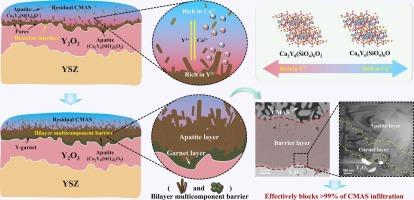等离子喷涂Y2O3/YSZ涂层中界面反应诱导的双层多组分阻挡层,具有优异的CMAS耐腐蚀性
IF 6.9
2区 材料科学
Q2 CHEMISTRY, PHYSICAL
引用次数: 0
摘要
钙镁铝硅酸盐(CMAS)腐蚀威胁着航空发动机热障涂层的耐久性。为了解决这个问题,我们开发了一种大气等离子喷涂(APS) Y2O3/YSZ双层涂层,可形成原位双层多组分屏障,防止熔融CMAS。通过1300 °C的界面反应研究,我们发现了致密的磷灰石-石榴石阻挡层。实验发现两种y -磷灰石相:Ca2Y8(SiO4)6O2在富Y3+界面处占优势,形成致密的磷灰石层;而Ca4Y6(SiO4) 60在Ca2+富集区结晶,消耗碱性氧化物增加CMAS粘度。长时间暴露进一步产生y -石榴石相,建立二级保护屏障。第一原理DFT计算证实,Ca2Y8(SiO4)6O2具有最高的热力学稳定性,形成焓为−355.087 kJ/mol,结合能为−8.127 eV/原子,证明了其在势垒层中的优势。这种由磷灰石和石榴石层组成的双层多组分屏障,在24 h后有效地完全阻断CMAS的渗透,为下一代tbc提供了抗CMAS腐蚀的特殊保护。本文章由计算机程序翻译,如有差异,请以英文原文为准。


Interfacial reaction-induced bilayer multicomponent barrier in plasma-sprayed Y2O3/YSZ coatings for superior CMAS corrosion resistance
Calcium-magnesium-alumino-silicate (CMAS) corrosion threatens the durability of thermal barrier coatings (TBCs) in aero-engines. To address this, we developed an atmospheric plasma-sprayed (APS) Y2O3/YSZ bilayer coating that forms an in-situ bilayer multicomponent barrier against molten CMAS. Through interfacial reaction studies at 1300 °C, we identified a dense apatite-garnet barrier layer. Experiments reveal two Y-apatite phases: Ca2Y8(SiO4)6O2 dominates at Y3+-rich interfaces, forming a dense apatite layer; while Ca4Y6(SiO4)6O crystallizes in Ca2+-rich regions, consuming basic oxides to increase CMAS viscosity. Prolonged exposure further yields Y-garnet phase, establishing a secondary protective barrier. First-principles DFT calculations confirm that Ca2Y8(SiO4)6O2 exhibits the highest thermodynamic stability, with a formation enthalpy of −355.087 kJ/mol and a cohesive energy of −8.127 eV/atom, rationalizing its dominance in the barrier layer. This bilayer multicomponent barrier composed of apatite and garnet layers, effectively and completely blocks CMAS infiltration after 24 h, demonstrating exceptional protection for next-generation TBCs against CMAS corrosion.
求助全文
通过发布文献求助,成功后即可免费获取论文全文。
去求助
来源期刊

Applied Surface Science
工程技术-材料科学:膜
CiteScore
12.50
自引率
7.50%
发文量
3393
审稿时长
67 days
期刊介绍:
Applied Surface Science covers topics contributing to a better understanding of surfaces, interfaces, nanostructures and their applications. The journal is concerned with scientific research on the atomic and molecular level of material properties determined with specific surface analytical techniques and/or computational methods, as well as the processing of such structures.
 求助内容:
求助内容: 应助结果提醒方式:
应助结果提醒方式:


